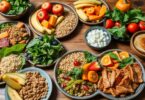The average American consumes over 3,600 calories daily, exceeding the recommended amount. This alarming fact underscores the necessity for healthier eating habits. Such habits are crucial for enhancing well-being and quality of life. In this guide, we delve into the basics of healthy eating. We also explore the art of crafting delicious, nutritious meals. You’ll gain the tools and strategies needed for a balanced lifestyle.
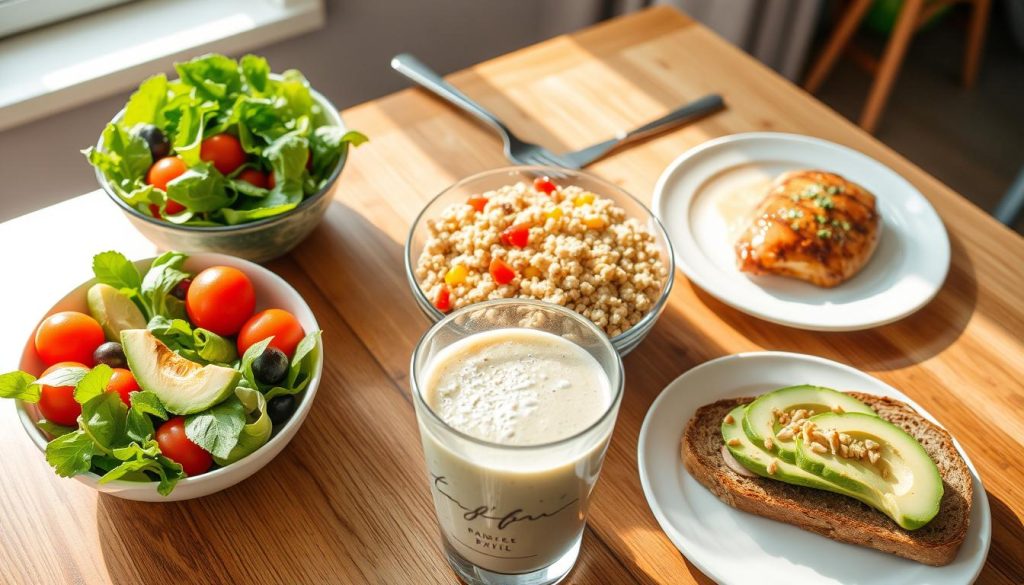
Key Takeaways
- Understand the essential principles of balanced nutrition and the role of macronutrients in a healthy diet.
- Learn how to plan and prepare nutritious meals that fuel your body and mind throughout the day.
- Discover smart grocery shopping strategies to ensure you have the right ingredients on hand for success.
- Explore a variety of breakfast, lunch, and dinner options that are both delicious and good for you.
- Incorporate healthy snacking habits and meal prep techniques to support your daily routines.
Understanding the Foundations of Healthy Eating
Achieving a balanced and nutritious diet is the cornerstone of a healthy lifestyle. To make informed food choices, it’s essential to understand the basic principles of nutrition. This includes the importance of essential food groups and the role of macronutrients in our diets.
Basic Nutrition Principles
Proper nutrition is the foundation for overall well-being. It involves consuming a variety of whole foods. These include fruits, vegetables, whole grains, lean proteins, and healthy fats. These foods provide your body with the necessary vitamins, minerals, and other essential nutrients.
Following a balanced, nutrient-dense diet can help support optimal physical and mental health. It’s crucial for maintaining a healthy lifestyle.
Essential Food Groups Explained
- Fruits and Vegetables: These provide a wealth of vitamins, minerals, and antioxidants. They support immune function, skin health, and digestive health.
- Whole Grains: Whole grains, such as quinoa, brown rice, and oats, are rich in fiber, complex carbohydrates, and B vitamins. They contribute to sustained energy and optimal gut health.
- Lean Proteins: Lean protein sources, including poultry, fish, legumes, and eggs, are essential. They are crucial for building and repairing muscle tissue, as well as supporting hormone production and immune function.
- Healthy Fats: Fats like those found in avocados, nuts, seeds, and fatty fish are crucial. They are essential for brain function, hormone regulation, and heart health.
The Role of Macronutrients
Macronutrients are the three main categories of nutrients that provide calories and support various bodily functions. They include carbohydrates, proteins, and fats. Balancing these macronutrients in your diet can help maintain stable blood sugar levels.
It also promotes muscle growth and recovery, and supports overall metabolic health.
| Macronutrient | Function | Food Sources |
|---|---|---|
| Carbohydrates | Primary source of energy for the body and brain | Whole grains, fruits, vegetables, legumes |
| Proteins | Building blocks for muscles, organs, and tissues | Lean meats, poultry, fish, eggs, legumes |
| Fats | Support hormone production, brain function, and heart health | Avocados, nuts, seeds, olive oil, fatty fish |
By understanding these foundational nutrition principles, you can make informed choices. These choices nourish your body and support a healthy, balanced lifestyle.
Planning Your Daily Meals for Success
Creating a successful meal plan is crucial for a balanced and nutritious diet. By planning your meals, you ensure your body gets the nutrients it needs. This approach helps you reach health goals and simplifies your daily routine.
Building a Balanced Meal Plan
Begin by focusing on essential food groups: fruits, vegetables, whole grains, lean proteins, and healthy fats. Aim to mix these in your meals for a variety of vitamins and minerals. This not only boosts your health but also adds flavor to your meals.
Meal Prep for Convenience
Meal prep can revolutionize your healthy lifestyle. Preparing meal components ahead saves time and reduces stress. Simple tasks like chopping veggies or cooking proteins can greatly simplify your day.
Grocery Shopping Strategies
Before shopping, review your meal plan and make a detailed list. This keeps you organized and ensures you have all needed ingredients. Also, choose seasonal and local produce for better nutrition and taste.
| Meal Planning Tips | Meal Prep Techniques | Grocery Shopping Essentials |
|---|---|---|
| Incorporate a variety of food groups Balance macronutrients (protein, carbs, and fats) Consider dietary preferences and restrictions | Chop and store vegetables in advance Cook and freeze proteins for easy reheating Prepare sauces, dressings, and marinades ahead of time | Create a detailed shopping list Prioritize fresh, seasonal produce Compare prices and look for budget-friendly options |
Adopting these meal planning, prep, and shopping strategies will lead to a diverse and nutritious diet. This supports your health and wellness.
Smart Grocery Shopping Strategies
Grocery shopping can seem overwhelming, but with the right approach, it becomes easy and sustainable. Whether you’re looking for affordable meals or want to add more seasonal ingredients to your diet, these tips will guide you. They make navigating the grocery store a breeze.
Creating an Effective Shopping List
Start by making a detailed shopping list before you go to the store. This simple step keeps you organized, prevents impulse buys, and ensures you have everything needed for your meals. Organize items by category or aisle to make your shopping trip more efficient.
Choosing Fresh and Seasonal Ingredients
Choosing fresh ingredients is crucial for a healthy, sustainable eating lifestyle. Opt for locally-sourced, seasonal produce for better taste and nutrition. Shopping seasonally supports your local economy and lets you enjoy nature’s best.
Budget-Friendly Shopping Tips
- Check the store’s weekly sales for discounts on fresh ingredients and budget-friendly meals.
- Choose store-brand or generic products for quality at a lower cost.
- Buy non-perishable items like grains, nuts, and spices in bulk to save money.
- Consider frozen fruits and vegetables, which are nutritious and last longer than fresh.
| Seasonal Produce | Budget-Friendly Alternatives |
|---|---|
| Tomatoes | Canned diced tomatoes |
| Leafy greens | Frozen spinach or kale |
| Apples | Applesauce or apple slices |
By adopting these grocery shopping strategies, you can enjoy fresh ingredients, budget-friendly meals, and a more sustainable eating lifestyle. You won’t have to compromise on quality or taste.

Essential Kitchen Tools for Healthy Cooking
Preparing nutritious meals at home requires the right tools and equipment. From basic utensils to specialized appliances, having the essential kitchen essentials can make all the difference in your healthy cooking journey. Let’s explore the must-have items that will simplify food preparation and enhance your ability to create delicious, wholesome dishes.
Versatile Knives and Cutting Boards
A high-quality set of knives is a fundamental tool for any home cook. Invest in a chef’s knife, paring knife, and serrated bread knife to tackle a variety of cutting tasks with ease. Pair your knives with durable, non-slip cutting boards to ensure safe and efficient food preparation.
Meal Prep Containers
Meal prep containers are essential for planning and storing healthy meals in advance. Look for leak-proof, BPA-free containers with compartments to separate your food groups. These handy tools make it simple to portion out balanced meals and grab-and-go throughout the week.
| Kitchen Essential | Benefits for Healthy Cooking |
|---|---|
| High-Quality Blender | Blends fruits, vegetables, and protein-rich ingredients into nutrient-dense smoothies and purees. |
| Instant Pot or Slow Cooker | Allows for easy, hands-off cooking of wholesome, one-pot meals. |
| Digital Food Scale | Ensures accurate portioning for better calorie and nutrient control. |
With these essential kitchen tools on hand, you’ll be well on your way to preparing delicious and healthy meals with ease. Experiment with different gadgets and find what works best for your cooking style and meal prep needs.

Breakfast Ideas That Fuel Your Morning
Starting your day with a nutritious breakfast is crucial for sustaining energy and focus throughout the day. Whether you’re short on time or craving something heartier, these breakfast ideas will help you power up your mornings with a delicious and balanced meal.
Quick Protein-Rich Options
For a quick protein boost, consider yogurt parfaits with fresh berries and granola, or a veggie-packed omelet with a side of whole-grain toast. Scrambled eggs with avocado and a sprinkle of feta cheese are another simple yet satisfying option.
Make-Ahead Breakfast Solutions
Busy mornings don’t have to mean skipping breakfast. Prepare overnight oats with chia seeds, nuts, and your favorite fruits for a grab-and-go breakfast that’s ready when you are. Breakfast burritos or frittata muffins made in advance can also be a lifesaver on hectic weekdays.
Energy-Boosting Morning Meals
Start your day on a high note with energy-rich breakfast bowls. Blend a smoothie with spinach, banana, and peanut butter for a nutrient-dense drink, or enjoy a bowl of steel-cut oats topped with sliced almonds and a drizzle of honey.
| Breakfast Idea | Nutrients | Preparation Time |
|---|---|---|
| Avocado Toast with Poached Egg | Healthy fats, protein, fiber | 10 minutes |
| Berry Chia Pudding | Antioxidants, omega-3s, fiber | 5 minutes (plus overnight chilling) |
| Spinach and Feta Breakfast Wrap | Protein, vitamins, minerals | 15 minutes |
Remember, a balanced breakfast is the foundation for a productive and energized day. By incorporating these quick, make-ahead, and nutrient-dense breakfast ideas, you can fuel your body with the essential nutrients it needs to thrive.
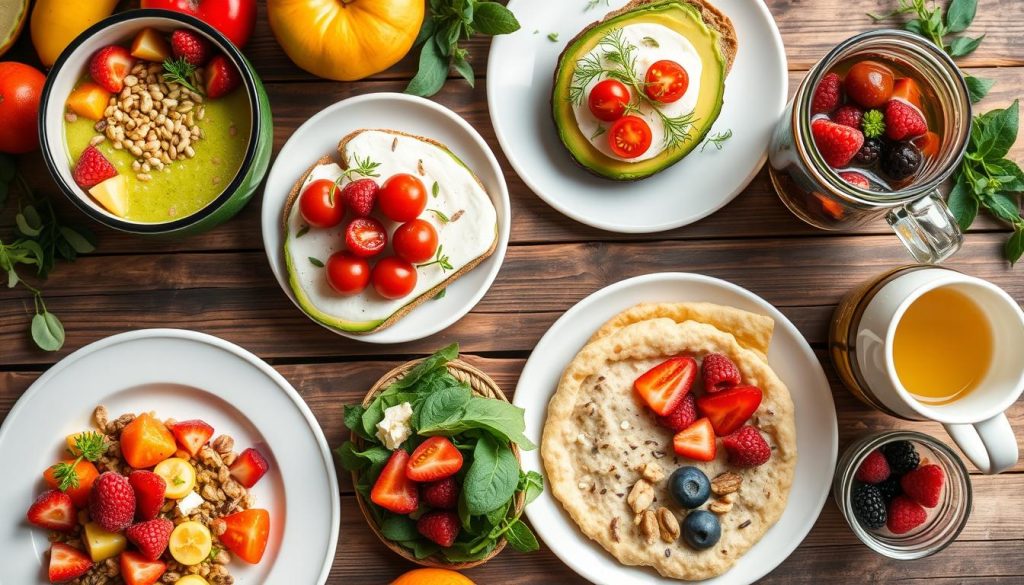
Nutritious Lunch Options for Work and Home
Lunch is key to a balanced diet, influencing the rest of your day. Whether at work or home, a nutritious lunch boosts energy and keeps you on track with health goals.
Healthy lunch recipes don’t need to be complex or time-consuming. Focus on quick healthy meals and meal prep to enjoy tasty, satisfying lunches. These support a balanced diet and portion control.
- Try a hearty veggie-packed salad with grilled chicken or roasted tofu for a filling and nutrient-dense option.
- Wrap up your favorite lean protein, whole grains, and fresh produce in a whole-wheat tortilla or pita for a portable and satisfying lunch.
- Pack a bento-style lunch box with a variety of components, such as roasted sweet potato, boiled eggs, and a side of raw veggies with hummus.
Remember, portion control is crucial for a healthy lifestyle. Be mindful of your serving sizes. Aim for a balance of lean proteins, complex carbohydrates, and healthy fats in your lunch recipes.
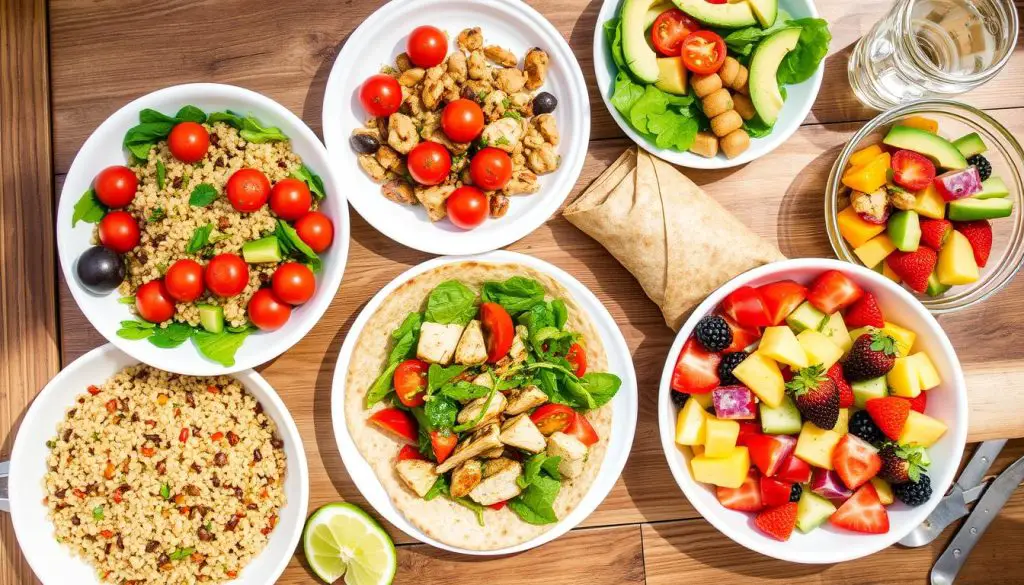
“The secret to a nutritious and satisfying lunch is preparation. Meal prepping your lunches for the week can save you time and ensure you have a healthy option on hand.”
By incorporating these quick healthy meals and meal prep tips into your daily routine, you can enjoy nourishing and energy-boosting lunches. These support your overall well-being.
Balanced Dinner Recipes for the Whole Family
Mealtime is a cherished opportunity to bring the family together and nourish both body and soul. Crafting balanced dinner recipes that cater to various tastes and dietary needs can be a rewarding challenge. In this section, we’ll explore a variety of healthy, family-friendly dinner ideas that will have your loved ones eagerly anticipating the dinner bell.
30-Minute Healthy Dinner Ideas
Busy weeknights call for quick, nutritious meals that can be prepared in a flash. Fortunately, there are numerous dinner ideas that strike the perfect balance between speed and health. From protein-packed stir-fries to veggie-loaded pasta dishes, these 30-minute meals will have a wholesome dinner on the table in no time.
One-Pan Meal Solutions
Simplify your cooking routine with easy-to-prepare one-pan recipes. These family meals minimize cleanup while delivering a complete, balanced diet. Roast a medley of fresh vegetables alongside lean protein for a satisfying quick healthy meal, or try a one-skillet burrito bowl packed with fiber and antioxidants.
Family-Friendly Recipes
Appealing to a range of ages and preferences can be a challenge, but there are plenty of balanced diet recipes that the whole family will enjoy. Hearty casseroles, flavorful sheet-pan dinners, and customizable taco nights are just a few examples of one-pan recipes that bring everyone to the table.

By incorporating these practical and delicious dinner ideas into your weekly meal planning, you can nourish your loved ones with wholesome, family-friendly meals that promote connection and a balanced lifestyle.
Smart Snacking Between Daily Meals
Keeping a balanced diet isn’t just about the main meals. It’s also about the healthy snacks we choose throughout the day. Snacking helps keep our energy up, controls hunger, and gives us vital nutrients. By picking wisely, we can enjoy healthy snacks that enhance our daily meals and boost our well-being.
Nutrient-Dense Snack Options
For healthy snacking, aim for snacks that are packed with nutrients and offer lasting energy. Some excellent options include:
- Fresh fruits and vegetables, such as apple slices, carrot sticks, or berries
- Greek yogurt with a sprinkle of nuts or seeds
- Hummus with whole-grain crackers or bell pepper strips
- Hard-boiled eggs
- Mixed nuts and seeds
- Edamame
Portion Control for Snacks
Snacking is great for keeping energy up and nutrient levels high, but it’s key to control portions. Stick to recommended sizes to avoid overeating and keep your diet balanced. A good rule of thumb is to aim for snacks around 100-200 calories.
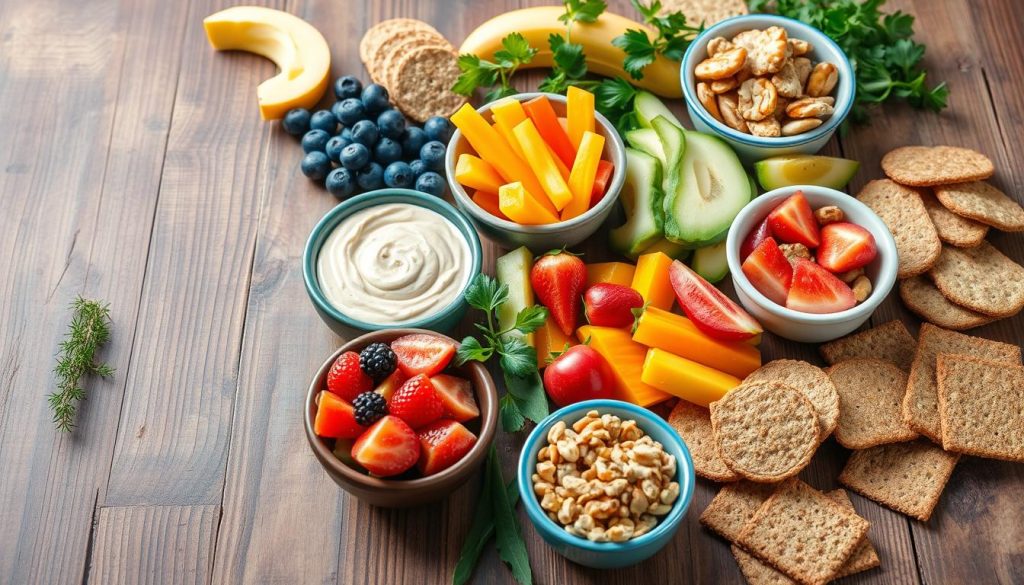
Mindful Snacking Strategies
To align your snacking with your health goals, adopt a more mindful approach. This might involve:
- Avoiding mindless snacking while distracted
- Listening to your body’s hunger and fullness cues
- Planning ahead and packing nutrient-dense meals and energy-boosting foods
- Incorporating a variety of healthy snacks to keep your taste buds engaged
By choosing wisely and controlling portions, you can develop a healthier snacking habit. This supports your overall wellness goals.
Meal Prep Strategies for Busy Lifestyles
In today’s fast-paced world, finding time to prepare healthy meals can be a challenge. However, meal prep is a game-changer that can help you save time and maintain a nutritious diet, even on the busiest of schedules. Let’s explore some effective time-saving prep techniques, storage and organization tips, and batch cooking guidelines to make your life easier.
Time-Saving Prep Techniques
Efficiency is the key when it comes to meal prep. Start by dedicating a few hours on the weekend to chop, cook, and portion out your ingredients. This simple step can save you significant time during the week. Additionally, consider investing in kitchen tools like a food processor or high-speed blender to streamline your prep work.
Storage and Organization Tips
Proper storage and organization are crucial for successful meal prep. Invest in high-quality containers and labeled storage bins to keep your prepped ingredients fresh and easily accessible. Utilize the freezer for make-ahead meals and batch-cooked items, which can be quickly reheated on busy weeknights.
Batch Cooking Guidelines
Batch cooking is a fantastic way to save time and effort. Focus on recipes that can be easily doubled or tripled, such as soups, stews, and casseroles. Prepare large portions and divide them into individual servings for quick and convenient meals throughout the week.
By implementing these meal prep strategies, you can take control of your health and simplify your daily routine. Embrace the time-saving benefits of food prep tips and batch cooking, and unlock a more balanced and stress-free lifestyle.
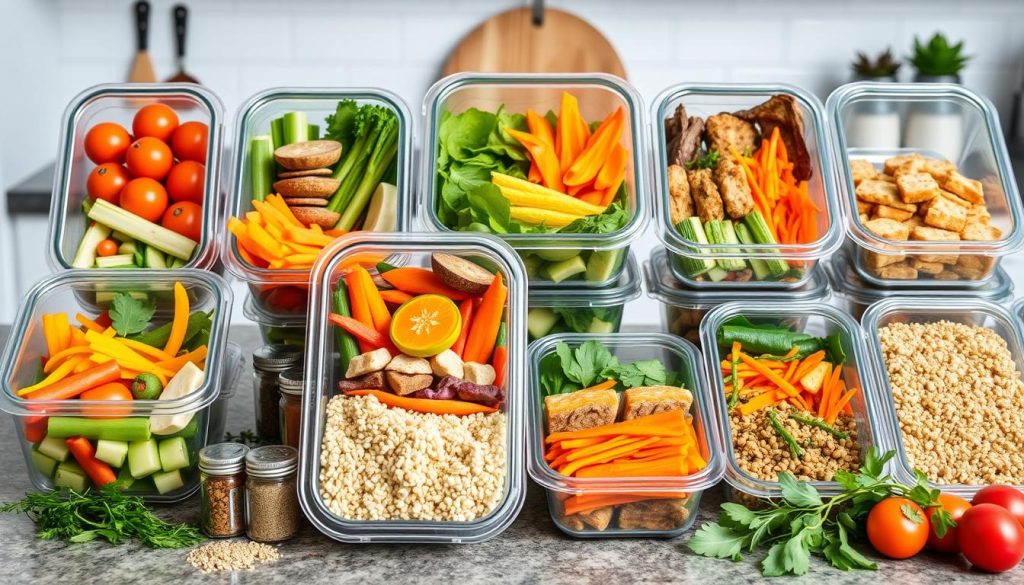
Understanding Portion Control and Serving Sizes
Maintaining a balanced diet is essential for a healthier lifestyle. Understanding portion control is key. It involves being mindful of the food quantity you consume, ensuring servings match recommended guidelines. By mastering portion control, you can enjoy your favorite foods while supporting weight management and overall well-being.
Recognizing standard serving sizes is a fundamental aspect of portion control. Serving sizes are the recommended amounts of different food groups for a balanced meal. For instance, a serving of cooked rice is about 1/2 cup, while a serving of meat or fish is 3-4 ounces. Knowing these sizes helps you create nutritious meals and avoid overeating.
- Use visual cues to estimate portion sizes, such as the size of your palm for a serving of protein or a tennis ball for a serving of fruit.
- Measure your food using measuring cups and spoons to ensure you’re staying within the recommended serving sizes.
- Slow down and savor your meals, allowing your body to recognize when you’re feeling satisfied, rather than relying on the clean plate as a sign of being full.
Practicing mindful eating is another powerful tool for portion control. This approach involves being present and attentive during meals, focusing on flavors, textures, and aromas. By slowing down and being more mindful, you can better recognize your body’s hunger and fullness cues. This prevents overeating and supports a balanced diet.
“The key to portion control is not deprivation, but rather awareness and moderation.”
Incorporating portion control strategies into your daily routine can significantly impact your health and weight management. By being mindful of serving sizes and practicing mindful eating, you can enjoy your favorite foods while nourishing your body and supporting a balanced diet.

Incorporating Superfoods into Your Diet
Superfoods are nutritional powerhouses that can elevate your daily meals and boost your overall health. By incorporating these nutrient-dense foods into your diet, you can unlock a world of benefits. These include enhanced immunity and increased energy levels.
Top Nutrient-Dense Foods
Some of the top superfoods that should be a part of your healthy eating regimen include:
- Blueberries: Packed with antioxidants, these berries can improve brain function and reduce inflammation.
- Kale: This leafy green is a rich source of vitamins A, C, and K, as well as fiber and essential minerals.
- Salmon: Oily fish like salmon are renowned for their omega-3 fatty acids, which support heart and brain health.
- Chia seeds: These tiny seeds are a treasure trove of fiber, protein, and essential nutrients like calcium and magnesium.
Creative Ways to Use Superfoods
Incorporating superfoods into your daily meals doesn’t have to be complicated. Here are some creative ideas to try:
- Add a handful of spinach or kale to your morning smoothie for an extra nutrient boost.
- Sprinkle chia seeds or ground flaxseeds onto your yogurt, oatmeal, or avocado toast.
- Roast Brussels sprouts, carrots, or beets and toss them into salads or serve as a side dish.
- Swap out regular flour for almond or coconut flour when baking to increase the nutrient content.
Seasonal Superfood Guide
Embracing seasonal eating can also help you maximize the nutritional benefits of superfoods. For example, blueberries are at their peak during the summer months, while pomegranates are most abundant in the fall. Take advantage of these seasonal cycles to enjoy the freshest and most nutrient-rich superfoods throughout the year.
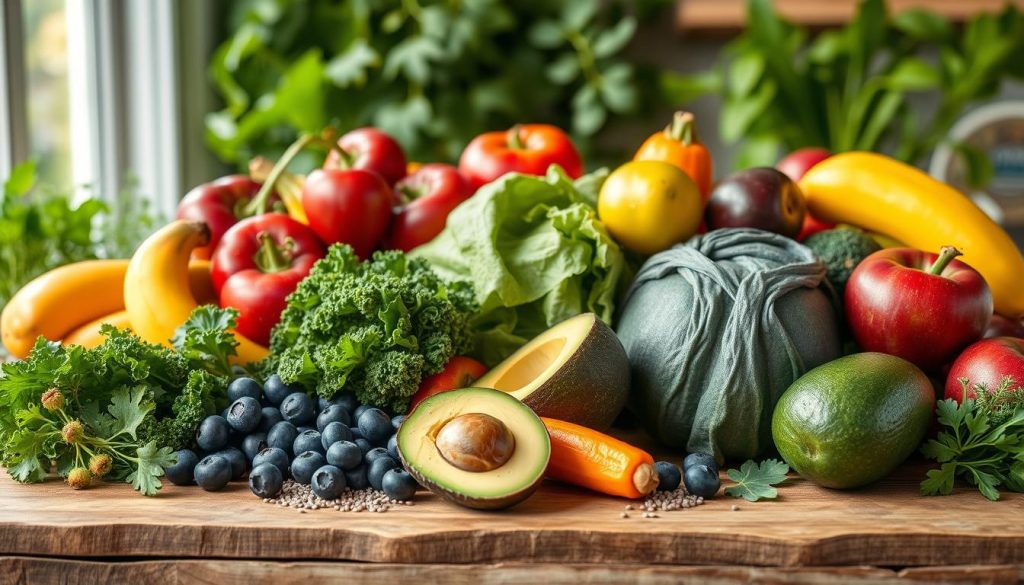
“Superfoods are not a magic bullet, but they can be a valuable part of a balanced, nutrient-rich diet.”
Conclusion
As we conclude this journey toward a healthier lifestyle, the importance of nutritious daily meals is clear. Understanding balanced nutrition, planning meals, and using smart shopping and cooking techniques are key. These steps unlock the doors to a vibrant, wellness-focused lifestyle.
We’ve explored essential food groups, the role of macronutrients, and the power of superfoods. We’ve also shared a wealth of breakfast, lunch, and dinner ideas. These ideas fuel your body and nourish your soul. By embracing portion control, meal prep, and diverse flavors, you can sustain a healthy lifestyle that boosts your well-being.
Remember, your journey to a healthier you is ongoing. But with the tools and insights here, you’re ready to make informed choices and enjoy delicious meals. Start a rewarding path towards a vibrant, balanced life. Let healthy daily meals be the foundation for a life filled with energy, vitality, and wellness.
FAQ
What are the basic principles of healthy eating?
Healthy eating focuses on whole, minimally processed foods. It emphasizes a balanced intake of macronutrients like carbohydrates, proteins, and healthy fats. Ensuring a variety of nutrient-dense foods from all major food groups is also key.
How do I plan healthy meals for my daily routine?
Start by creating a weekly meal plan with a variety of nutritious foods. Consider your schedule, dietary needs, and preferences. Make a detailed grocery list to streamline shopping. Batch cooking and meal prepping save time and ensure healthy options all week.
What are some smart strategies for grocery shopping?
Smart grocery shopping involves creating a comprehensive shopping list. Focus on fresh, seasonal ingredients and look for budget-friendly options. Avoid impulse buys and shop the store’s perimeter for whole, unprocessed foods.
What are the essential kitchen tools for healthy cooking?
Essential tools include a good chef’s knife and high-quality pots and pans. A blender or food processor, slow cooker, or Instant Pot are also crucial. Add a variety of utensils like wooden spoons, tongs, and measuring cups and spoons. These tools simplify meal prep.
What are some healthy and delicious breakfast ideas?
Healthy breakfasts include Greek yogurt with fresh fruit and nuts, and overnight oats with chia seeds and berries. Try egg scrambles with vegetables, avocado toast with a boiled egg, and smoothie bowls with spinach, protein powder, and almond butter.
How can I incorporate more superfoods into my diet?
Add nutrient-dense ingredients like berries, leafy greens, chia seeds, quinoa, and salmon to your meals. Experiment with seasonal superfoods. Use them creatively, like adding kale to smoothies or roasting Brussels sprouts as a side dish.
What are some tips for understanding portion control?
Use smaller plates and measure servings to control portions. Be mindful of hunger and fullness cues. Familiarize yourself with standard serving sizes and use visual cues like the size of your palm or a tennis ball to estimate portions.





